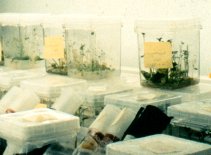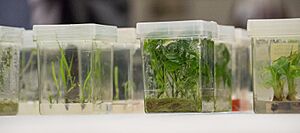Plant tissue culture facts for kids
Plant tissue culture is a cool way to grow plants from tiny pieces, like a single cell or a small bit of leaf, stem, or root. This is done in a super clean lab, not in soil. It relies on the amazing fact that many plant cells can grow into a whole new plant! This ability is called being totipotent.


This method is often used to make many exact copies of a plant. This process is called micropropagation. It has many benefits over traditional ways of growing plants:
- It can make exact copies of plants that have special features, like beautiful flowers or tasty fruits.
- It helps grow mature plants very quickly.
- You can produce a huge number of plants in a small space.
- It allows growing plants even if they don't produce seeds or need special insects to make seeds (like some orchids).
- It helps grow new plants from cells that have been changed using genetic engineering.
- Plants grown this way are in sterile (super clean) containers. This means they can be moved around without spreading diseases or pests.
- It helps grow plants from seeds that usually don't sprout easily, like orchids and Nepenthes.
- It can clean plants from viruses and other infections. Then, many healthy copies can be made quickly for farming.
- It helps store genetic material from plants to protect native species.
Contents
How Plant Tissue Culture Works
To grow plants using tissue culture, you need a very clean environment. This is done in a special room with HEPA filtered air, often using a `laminar flow cabinet`. This cabinet blows clean air to keep germs away.
The plant pieces are grown in sterile containers, like Petri dishes or flasks. These are kept in a room with controlled temperature and light.
Plants from outside are naturally covered in tiny living things like bacteria. So, their surfaces must be cleaned. This is done using chemical solutions, usually alcohol or bleach. After cleaning, small pieces of the plant, called `explants`, are taken.
These clean explants are then placed on a special plant food called `culture medium`. This food can be solid or liquid. It contains inorganic salts, some organic nutrients, vitamins, and special plant growth hormones. Solid food is made by adding a gelling agent, like agar, to the liquid food.
The mix of ingredients in the food, especially the plant hormones, greatly affects how the plant tissue grows. For example:
- Too much of a hormone called `auxin` often makes a lot of roots grow.
- Too much of a hormone called `cytokinin` might make shoots (stems and leaves) grow.
- A balance of both `auxin` and `cytokinin` often creates an unorganized clump of cells called `callus`.
As the plant cultures grow, small pieces are cut off and moved to new food. This helps them keep growing or change how they look. It takes skill to know which pieces to keep and which to throw away.
When shoots start to grow, they can be cut off and encouraged to grow roots using `auxin`. These tiny plantlets can then be moved to potting soil. They will grow into normal plants in a greenhouse.
How New Plants Grow in Culture
Different parts of a plant have different abilities to grow into a new plant. The most common parts used are the growing tips of stems, buds, and roots. These areas have cells that divide quickly and naturally have the right growth hormones.
It's important to know that how well a plant grows in tissue culture can be different for various plant types or even different kinds within the same plant species. So, scientists often need to find the best way to grow each specific plant.
There are three main ways new plants can grow in tissue culture:
- Growing from existing growing points: This is like taking a tiny stem tip and making it grow into a whole plant. This is often used to make many copies.
- Organogenesis: This means growing new organs (like shoots or roots) directly from the explant.
- Non-zygotic embryogenesis: This is like making tiny plant embryos from plant cells, similar to how a seed forms. These embryos can then grow into full plants. This method is great for making many plants from a single cell.
Choosing the Right Plant Piece (Explant)
The piece of plant used to start the culture is called an `explant`. Explants can come from many parts of a plant: shoots, leaves, stems, flowers, roots, or even single cells. As long as the cells are alive and can start dividing again, they can potentially grow into a new plant. This is part of the idea of `totipotency`.
However, not all cells or all plants work the same way. Some plant parts grow and regenerate better than others, and some might not grow at all. The choice of explant also affects if the new plants will have a normal set of chromosomes or half the normal set. Also, using the wrong explant can increase the risk of germs getting into the culture.
For making many copies of plants for sale, using existing growing points (like stem tips) is preferred. This is because it has the lowest risk of creating genetic changes in the new plants. Making embryos from cells (somatic embryogenesis) can produce even more plants and can be done in large liquid containers called `bioreactors`.
Some explants, like root tips, are hard to get without dirt and germs. These germs can grow faster than the plant tissue and spoil the culture. Plant parts that grow above the soil are easier to clean.
Another way to get clean explants is to grow seedlings from seeds that have been cleaned. Seeds are tougher and can handle stronger cleaning solutions than other plant parts.
One important thing to remember is that plants grown through tissue culture are `clones`. This means they are exact copies of the original plant. If the original plant was easily affected by a disease, all the cloned plants will also be susceptible. But on the bright side, any good traits of the original plant will also be passed on to all the clones.
What Plant Tissue Culture is Used For
Plant tissue culture is used in many areas, including plant science, forestry, and gardening. Here are some of its uses:
- Making many plants for sale: It's used to produce large numbers of identical plants for gardens, landscaping, and flower shops.
- Saving rare plants: It helps protect plant species that are rare or in danger of disappearing.
- Plant breeding: Plant breeders can use tissue culture to test plant cells for good traits, like being resistant to weed killers, instead of testing whole plants.
- Making useful compounds: Large amounts of plant cells can be grown in liquid in `bioreactors` to produce valuable substances, like plant-based medicines.
- Creating new plant types: It can combine cells from different plant species to create new `hybrid` plants that wouldn't normally form.
- Studying plants: It helps scientists quickly learn how plants grow, how they work inside, and how they reproduce. For example, they can find plants that can handle stress better.
- Rescuing embryos: It can save plant embryos that would normally die if two distantly related species are crossed.
- Changing chromosomes: It can be used to double the number of chromosomes in a plant, creating new plant types like `tetraploids`. This is often done using chemicals like `colchicine`.
- Making genetically modified plants: It's used to introduce new genes into plants and then grow those `transgenic` plants.
- Cleaning up diseases: Techniques like `meristem tip culture` can produce healthy, virus-free plants from infected ones, like sugarcane or potatoes.
- Producing sterile hybrids: It can create identical hybrid plants that are sterile.
- Making artificial seeds: It can produce large numbers of artificial seeds from plant embryos grown in culture.
See also
 In Spanish: Cultivo de tejidos vegetales para niños
In Spanish: Cultivo de tejidos vegetales para niños
- Hairy root culture
- Gottlieb Haberlandt, a pioneer in plant tissue culture
- Frederick Campion Steward, another important pioneer in plant tissue culture
- Murashige and Skoog medium and Hoagland solution, important plant growth media
- Plant physiology

